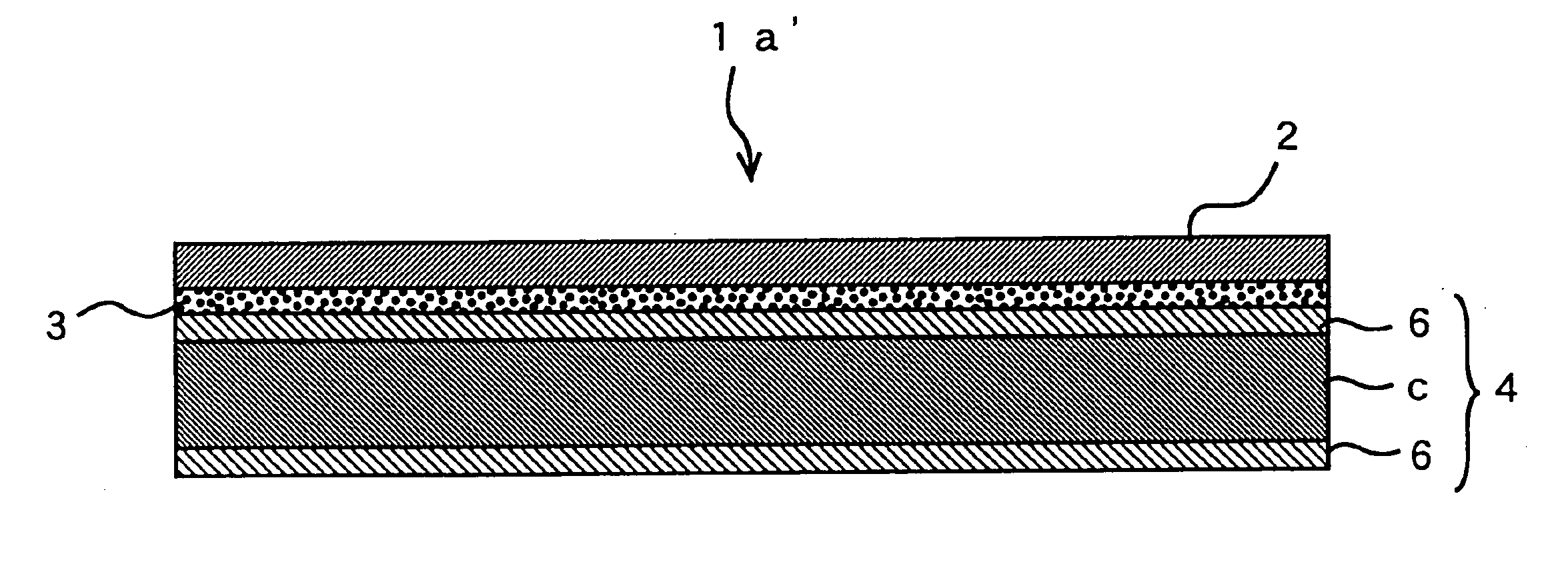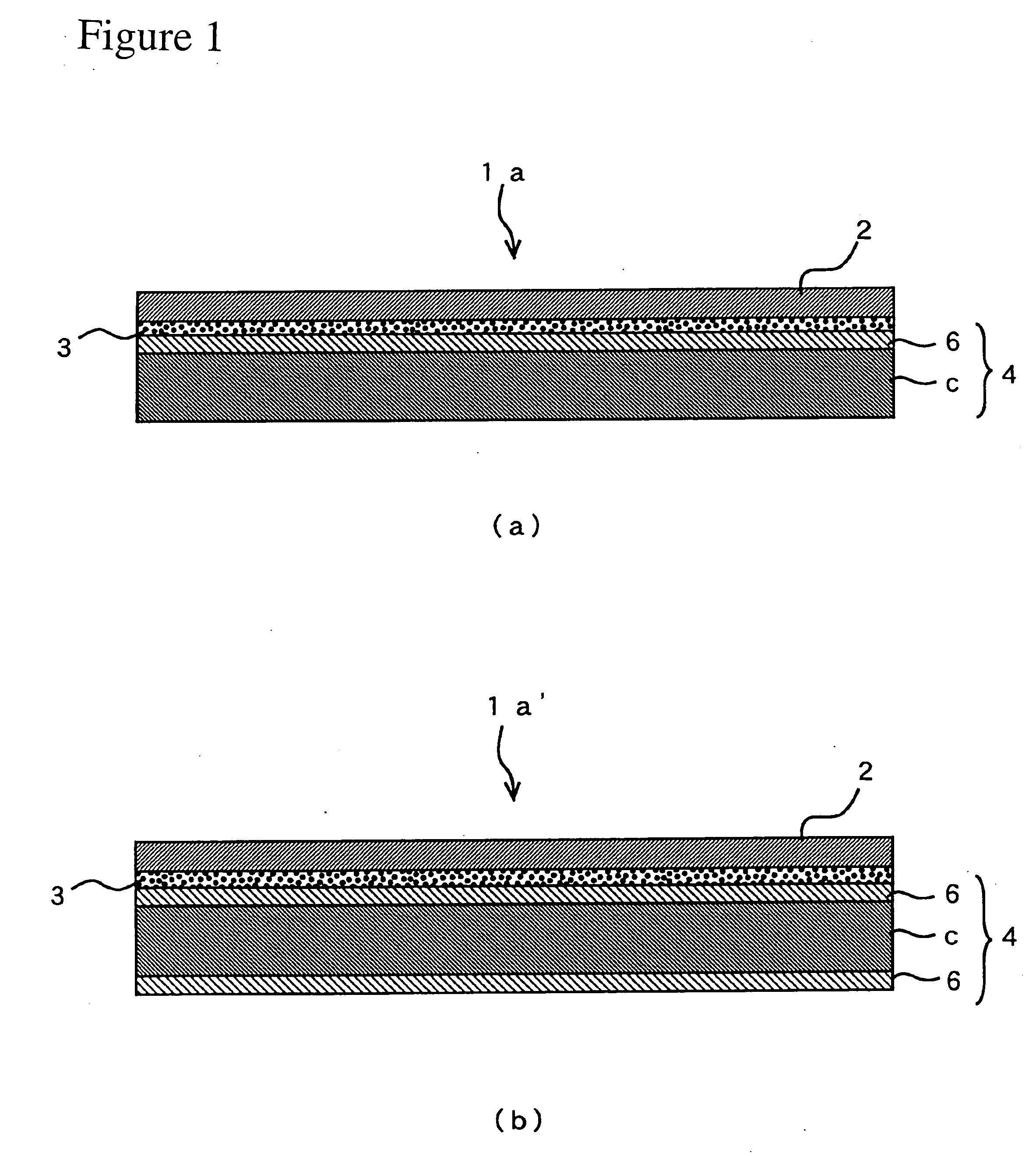Capacitor layer forming material, method of manufacturing a composite foil used where manufacturing the same, and print wiring board having a circuit where a capacitor is embedded, obtained by using the same
a technology of capacitor layer and forming material, which is applied in the direction of printed capacitor incorporation, fixed capacitor details, fixed capacitors, etc., can solve the problems of reducing the thickness of the capacitor layer forming material itself, limiting the improvement of the surface area of the capacitor, and unable to increase the capacitor electrode area beyond a certain level, etc., to achieve high adhesion and withstand expansion
- Summary
- Abstract
- Description
- Claims
- Application Information
AI Technical Summary
Benefits of technology
Problems solved by technology
Method used
Image
Examples
example 1
[0113] Example 1 produced the first composite foil provided with a plated hard nickel layer, capacitor layer forming material using the first composite foil, and printed wiring board with a built-in capacitor circuit.
[0114] An electrolytic copper foil (thickness: 12 μm, VLP foil, Mitsui Mining & Smelting) was dipped in an electrolytic plating solution of hard nickel of the following composition, and plated under the following conditions to form a plated hard nickel layer on the foil, to a thickness of 2 μm on the glossy surface and to a thickness equivalent to 3 μm on the rough surface. The resulting first composite foil had a total thickness of 17.5 μm. Thickness of the dissimilar metal layer, described in this specification, means the value based on the coating weight for forming the layer of given thickness on a flat surface by plating. Thickness of the actually produced composite foil means gauge thickness. The same applies to the composite foils produced in all Examples and Co...
example 2
[0127] Example 2 produced the first composite foil provided with a cobalt layer, capacitor layer forming material using the first composite foil, and printed wiring board with a built-in capacitor circuit.
[0128] An electrolytic copper foil (thickness: 12 μm, VLP foil, Mitsui Mining & Smelting) was dipped in an electrolytic plating solution of cobalt of the following composition, and plated under the following conditions to form a plated cobalt layer on the foil, to a thickness of 2 μm on the glossy surface and to a thickness equivalent to 3 μm on the rough surface. The resulting first composite foil had a total thickness of 17.8 μm.
[0129] (Cobalt Plating Solution Composition)
CoSO4.7H2O180g / LH3BO330g / LCoagulant0.1g / L
(Acrylamide-based polymer, PN-171 ®, Kurita Kogyo)
[0130] (Plating Conditions)
Solution temperature35° C.pH4Current density10 A / dm2StirringAdopted
[0131] The second composite foil produced above was analyzed for its tensile strength and elongation under the normal sta...
example 3
[0133] Example 3 produced the first composite foil provided with a nickel / cobalt alloy layer, capacitor layer forming material using the first composite foil, and printed wiring board with a built-in capacitor circuit.
[0134] An electrolytic copper foil (thickness: 12 μm, VLP foil, Mitsui Mining & Smelting) was dipped in an electrolytic plating solution of nickel / cobalt alloy of the following composition, and plated under the following conditions to form a plated nickel / cobalt alloy layer on the foil, to a thickness of 2 μm on the glossy surface and to a thickness equivalent to 3 μm on the rough surface. The resulting first composite foil had a total thickness of 17.2 μm.
[0135] (Nickel / Cobalt Electrolytic Plating Solution Composition)
NiSO4.6H2O200 g / L NiCl2.6H2O36 g / LCoSO4.7H2O12 g / LH3BO330 g / LHCOONa45 g / L
[0136] (Plating Conditions)
Solution temperature45° C.pH4Current density10 A / dm2StirringAdopted
[0137] The third composite foil produced above was analyzed for its tensile stren...
PUM
 Login to View More
Login to View More Abstract
Description
Claims
Application Information
 Login to View More
Login to View More - R&D
- Intellectual Property
- Life Sciences
- Materials
- Tech Scout
- Unparalleled Data Quality
- Higher Quality Content
- 60% Fewer Hallucinations
Browse by: Latest US Patents, China's latest patents, Technical Efficacy Thesaurus, Application Domain, Technology Topic, Popular Technical Reports.
© 2025 PatSnap. All rights reserved.Legal|Privacy policy|Modern Slavery Act Transparency Statement|Sitemap|About US| Contact US: help@patsnap.com



